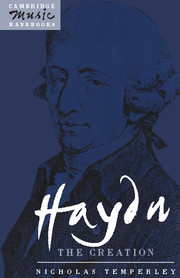Book contents
6 - Musical analysis
Published online by Cambridge University Press: 05 June 2012
Summary
The following discussion is organized by type of movement. Within each category is incorporated a more detailed description of one or more movements; these are listed in bold type under each heading and in the text.
Secco Recitative
Nos. 3 (bars 1–6), 5, 7, 9, 11, 16 (bars 1–5), 17, 23, 25, 31, 33
Recitative with basso continuo accompaniment only had been invented shortly before 1600 as the most sensitive and expressive kind of music imaginable; and in some seventeenth-century operas and oratorios the recitative soliloquy was reserved for the emotional climax of a work. In modern times simple recitative has been called secco (dry). By the end of the eighteenth century, although simple recitative was still an excellent vehicle for spontaneous expression on the part of the singer, composers tended to treat it as a perfunctory part of their craft – perhaps to be dashed off during the last few hours before a performance, or even left to a deputy. The conventions had become almost absolute; the chief skill required of the composer was to steer the tonality towards the next movement.
Haydn perhaps took more care in this case, knowing especially that he was dealing for the most part with biblical words. Italian recitative, with its standard verse form and feminine endings, could not provide examples of the variable rhythm needed for prose, and Haydn had to invent nonconventional cadences and phrases: this can be seen most clearly in No. 5.
Information
- Type
- Chapter
- Information
- Haydn: The Creation , pp. 65 - 88Publisher: Cambridge University PressPrint publication year: 1991
